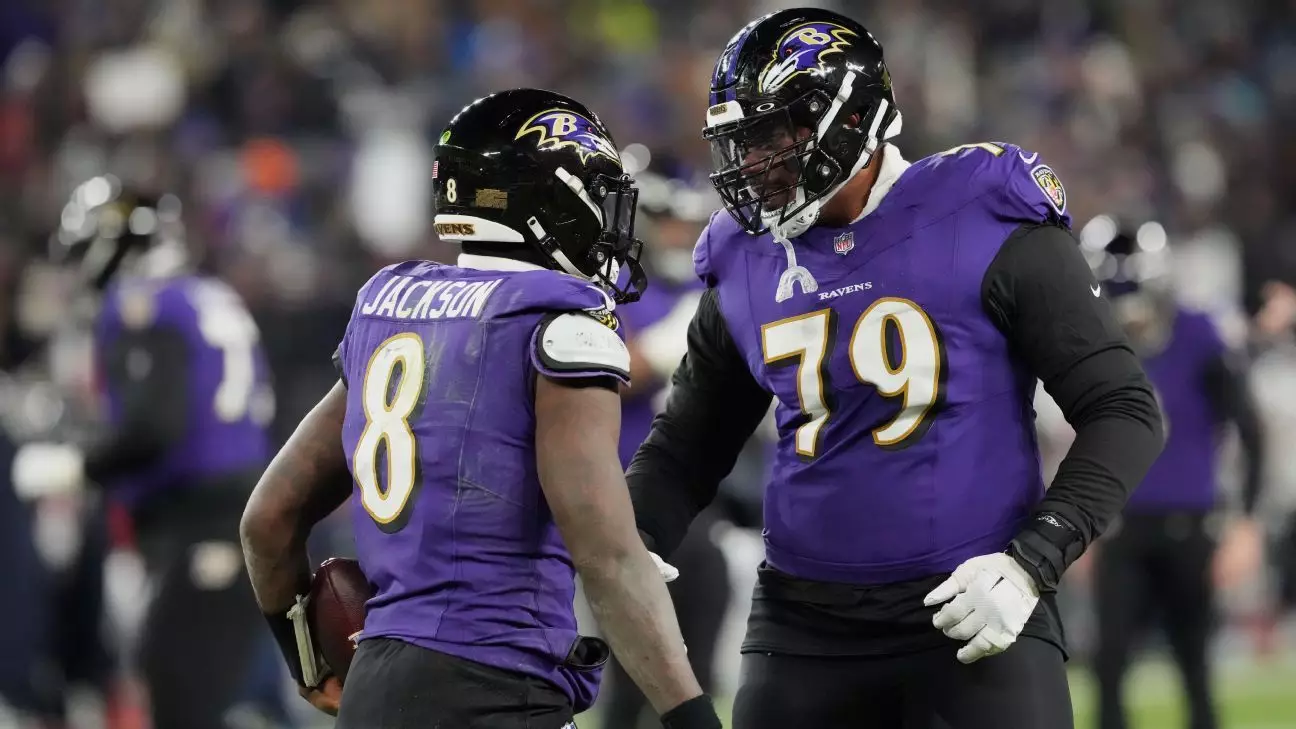Following the Baltimore Ravens’ devastating 27-25 playoff defeat to the Buffalo Bills, a heavy silence hung over the locker room, particularly for veteran offensive tackle Ronnie Stanley. Standing before reporters, Stanley found himself reflecting not just on the game but on his future with the franchise that drafted him with the sixth overall pick nearly a decade prior. “Who knows?” he muttered, echoing sentiments of uncertainty and disappointment. “This one is going to hurt for a while… I’m going to just take it day by day.” It’s a poignant reminder of the emotional toll that professional sports can exact on players, leaving them grappling not only with losses but the prospect of significant life changes and career pivots.
This moment encapsulates the broader decisions looming over the Ravens’ franchise, where the fate of a stalwart player hangs in the balance. Stanley has been the anchor of the Ravens’ offensive line since 2016, achieving Pro Bowl status twice. However, for the first time in his career, he finds himself entering free agency, raising the stakes of his emotional investment in the team.
In the wake of a highly scrutinized playoff performance, it’s important to note that this season reflected a resurgence for Stanley. He enjoyed his most productive year since sustaining a significant ankle injury in 2020, evidenced by a pass block win rate that ranked the tackles among the league’s best at 92.5%. Despite this achievement, Stanley’s age—approaching 31—and injury history, missing 36 games over the last five years, complicates the Ravens’ decision. Baltimore management, represented by general manager Eric DeCosta, is faced with the challenge of balancing the emotional attachment to a player who has embodied reliability within a high-stakes environment while also taking into account the financial ramifications tied to preserving such a talent.
Moreover, Stanley’s 24 penalties since 2022 present an additional layer of complexity. While his presence protects quarterback Lamar Jackson—one of the league’s most dynamic players—his discipline issues could be detrimental in critical moments. The Ravens’ own analysis suggests that further investment in Stanley (projected market value at $20.7 million per season) might not align with the current salary cap constraints that place them within the bottom tier of NFL teams concerning available funds.
The dilemma surrounding Stanley’s future raises critical discussions about talent retention versus strategic restructuring. Should Baltimore fail to re-sign their cornerstone tackle, the prospect of moving Roger Rosengarten from right tackle to the left side poses a viable solution. A rookie who has already demonstrated versatility in both tackle positions, Rosengarten could become the linchpin for an evolving offensive line. DeCosta’s endorsement of Rosengarten’s potential highlights a franchise philosophy that isn’t afraid to lean younger and more agile in a position typically reserved for seasoned players.
The Ravens’ commitment to a younger roster was evident last year when they replaced aging veterans like Kevin Zeitler and Morgan Moses, pivoting towards linemen who bring the enthusiasm and adaptability characteristic of newer leagues. This resulted in the team’s inaugural finish as the number one offense in franchise history. With a rushing attack that led the NFL in yards prior to first contact, the Baltimore offense demonstrated a willingness to innovate, even amid roster transitions.
Yet, with two crucial components of the offensive line—Stanley and left guard Patrick Mekari—entering free agency simultaneously, the organization must tread carefully. They cannot afford to underestimate the importance of keeping a cohesive unit, especially with a quarterback as elusive as Jackson. The potential loss of both linemen would not only require immediate tactical refinements but could alter the organizational ethos regarding team building going forward.
As the Ravens navigate this pivotal offseason, discussions about Stanley’s future will undoubtedly dominate the narrative. The franchise’s strategy will depend heavily on how they balance their immediate needs against long-term goals. DeCosta’s transparent acknowledgment of the difficulty of upcoming negotiations underlines the awareness that both player relationships and financial logistics will play a pivotal role in shaping the team’s trajectory.
For Stanley, the choice between accepting a lesser financial offer to remain with the team he loves or seeking a more lucrative deal elsewhere looms large. Such decisions extend beyond football; they encapsulate personal legacy, respect, and professional fulfillment. As Stanley confronts these crossroads, the Ravens organization must also reflect on core principles that define their competitive environment. Whether they lean towards retaining experienced leaders or embracing youthful energy, the decisions made in the coming months will set the tone for the team’s future and will undoubtedly be watched closely by fans and analysts alike.

